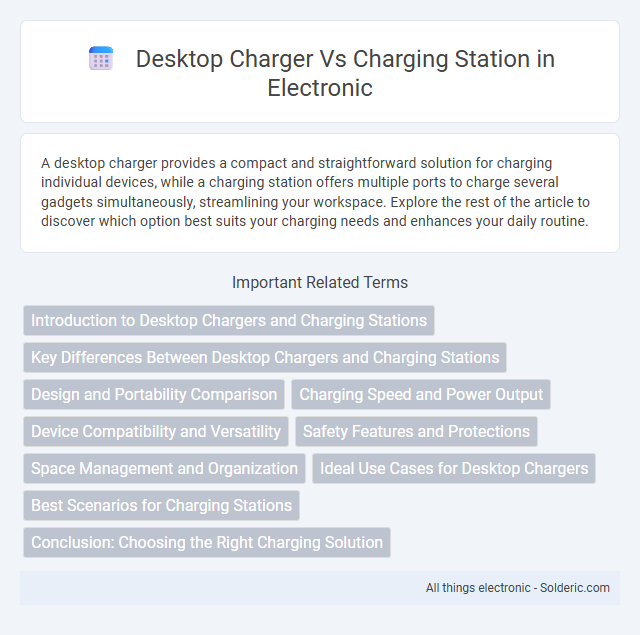A desktop charger provides a compact and straightforward solution for charging individual devices, while a charging station offers multiple ports to charge several gadgets simultaneously, streamlining your workspace. Explore the rest of the article to discover which option best suits your charging needs and enhances your daily routine.
Comparison Table
| Feature | Desktop Charger | Charging Station |
|---|---|---|
| Purpose | Charges a single device, usually on a desk | Charges multiple devices simultaneously |
| Capacity | 1-2 devices | 3 or more devices |
| Portability | Compact, easy to carry | Bulkier, designed for stationary use |
| Charging Speed | Standard, varies by device | Often supports fast charging for multiple devices |
| Power Source | Single USB or wall outlet | Multiple USB ports, sometimes wired power |
| Use Case | Individual users, home or office desks | Families, offices, or shared spaces |
| Cost | Generally low to moderate | Moderate to high |
Introduction to Desktop Chargers and Charging Stations
Desktop chargers provide a compact solution designed to charge one or multiple devices simultaneously, often featuring USB ports and wireless charging pads for convenience. Charging stations offer a more comprehensive charging hub, commonly supporting various device types with enhanced power management and organization features ideal for home or office setups. Both options prioritize efficient power delivery and cable management, but charging stations typically integrate advanced functionalities like fast charging and multi-device compatibility.
Key Differences Between Desktop Chargers and Charging Stations
Desktop chargers typically accommodate a single device, offering a compact solution for individual smartphone, tablet, or laptop charging. Charging stations, on the other hand, provide multiple ports or wireless pads designed to charge several devices simultaneously, making them ideal for families or office setups. The key differences lie in capacity, design purpose, and device compatibility, where desktop chargers emphasize portability and simplicity while charging stations focus on multifunctionality and centralized power management.
Design and Portability Comparison
Desktop chargers typically feature a compact, single-device design focused on minimalism, making them ideal for stationary use on a desk. Charging stations offer multi-device support with larger form factors, incorporating multiple ports and often bulkier builds that reduce portability but increase charging capacity. Your choice depends on whether you prioritize sleek design and mobility or the convenience of charging several devices simultaneously.
Charging Speed and Power Output
Desktop chargers usually provide moderate power output suitable for charging one or two devices efficiently, often supporting fast charging protocols that optimize your device's battery health. Charging stations deliver higher power output with multiple ports, enabling simultaneous fast charging of several devices without compromising speed. Selecting a charging station ensures your devices receive optimal power levels to reduce overall charging time compared to standard desktop chargers.
Device Compatibility and Versatility
Desktop chargers typically support single-device charging with limited ports, catering mainly to smartphones and tablets, while charging stations offer broader device compatibility including laptops, smartwatches, and other USB-powered gadgets. Charging stations feature multiple ports such as USB-A, USB-C, and wireless charging pads, enabling simultaneous charging of diverse devices with varied power requirements. This versatility makes charging stations ideal for households or offices with multiple electronic devices needing organized and efficient power management.
Safety Features and Protections
Desktop chargers often include basic safety protections such as overcharge, short circuit, and overheating prevention to safeguard devices during charging. Charging stations typically provide enhanced safety features, incorporating surge protection, intelligent current distribution, and temperature regulation to protect multiple devices simultaneously. Advanced charging stations may also offer certifications like UL or CE compliance, ensuring adherence to rigorous safety standards for user protection.
Space Management and Organization
Desktop chargers offer compact designs ideal for individual devices, helping you save space on your desk by reducing clutter and keeping cables tidy. Charging stations provide multi-device functionality with dedicated slots and cable management systems, optimizing organization for households or offices with several gadgets. Choosing the right option depends on your device quantity and space management needs, ensuring efficient charging and neat workspace arrangement.
Ideal Use Cases for Desktop Chargers
Desktop chargers are ideal for individual users who need a compact and efficient solution to charge a single device or a few gadgets at their workstation. These chargers provide focused power delivery, making them perfect for home offices or personal desks where space is limited and convenience is paramount. Unlike charging stations, desktop chargers offer simplicity and portability, favored in environments where quick, straightforward device charging is required.
Best Scenarios for Charging Stations
Charging stations excel in environments requiring simultaneous device charging, such as offices, classrooms, and public spaces, thanks to their multiple port configurations and high power output. They support a wide variety of devices including smartphones, tablets, laptops, and wearable technology, making them ideal for group settings and tech-heavy workflows. Compared to desktop chargers, charging stations offer superior organization and cable management, reducing clutter and enhancing accessibility for users.
Conclusion: Choosing the Right Charging Solution
Choosing the right charging solution depends on your device ecosystem and charging needs. A desktop charger typically supports fewer devices with faster charging for personal use, while a charging station offers multiple ports and compatibility for families or offices managing several gadgets simultaneously. Consider Your device count, charging speed requirements, and available space to select the most efficient and convenient option.
Desktop charger vs Charging station Infographic

 solderic.com
solderic.com